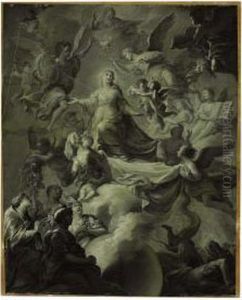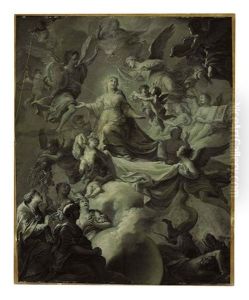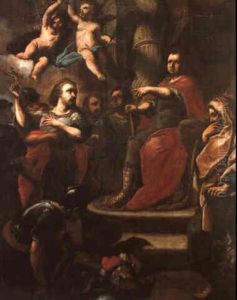Felix Anton Scheffler Paintings
Felix Anton Scheffler was an 18th-century German painter and fresco artist known for his work in the Baroque and Rococo styles. Born in 1701 in Mainburg, Bavaria, Scheffler was primarily active in Southern Germany and the region that is now the Czech Republic. His artistic talent emerged early, and he received his initial training from his father, Johann Scheffler, who was also a painter. Seeking to advance his skills, Felix Anton furthered his education by traveling and working with other artists of the time, which was a common practice for artists seeking to refine their craft.
Scheffler's work was characterized by the use of vivid colors, dynamic compositions, and the integration of architectural elements into his frescoes, which often gave the illusion of three-dimensional space. His paintings typically featured religious and mythological subjects, following the traditions of the Catholic Church, which was a major patron of the arts during the Baroque period. His frescoes adorn the walls and ceilings of numerous churches and buildings in Southern Germany and Bohemia. One of his most notable projects was the decoration of the library and the main staircase of the Oettingen-Wallerstein's residence in Harburg, which he completed in the 1730s.
Throughout his career, Scheffler evolved his style to suit the changing tastes of the period, transitioning from the grandeur of the Baroque to the lighter and more playful Rococo. Despite the popularity of his work during his lifetime, Scheffler, like many artists of his era, did not gain long-lasting fame, and his name is not as widely recognized as some of his contemporaries. Nonetheless, he left behind a significant body of work that continues to be appreciated for its artistic merit and historical value.
Felix Anton Scheffler passed away in 1760 in Passau, Germany. His works remain as a testimony to the artistic movements of the time and provide insight into the religious and cultural contexts of the regions in which he worked. Today, art historians and restoration experts work to preserve and study his contributions to the art world, ensuring that his legacy endures in the annals of art history.


